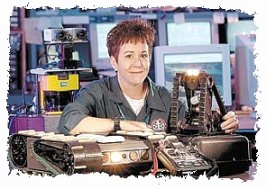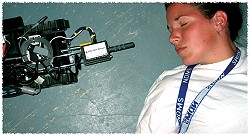Golden Age Technologies
Robots Join in Lifesaving Rescue Work

Dr. Robin Murphy with one of her robots.
By Sister-initiate Lorna, San Jose, California, USA (Originally in English)
In addition to being a professor of both Computer Science & Engineering
and Cognitive and Neural Sciences at the University of South Florida,
Dr. Robin
R. Murphy is also director of the University’s Center for Robot-Assisted
Search and Rescue (CRASAR).
And just two days after Hurricane Katrina hit the Gulf Coast, her unmanned
aerial vehicles (UAVs) assisted in relief efforts in Pearlington and Bay
St. Louis, Mississippi. The robotic craft proved to be valuable tools
in saving lives by scanning rooftops for stranded victims and in aiding
the injured by helping to perform triage (choosing patients who need immediate
transport to the hospital to save their lives as opposed to those who
can wait for help later).
Similar to many other groups that tried to enter New Orleans in hopes of assisting with the Katrina relief work, the CRASAR ran into various obstacles. However, through Dr. Murphy’s determination the UAVs acquired a bird’s eye view of Pearlington, relaying images showing that floodwaters in the area had receded and that no one was trapped on the rooftops. This was very advantageous since rescue crews were unable to evaluate the town due to the chaos produced by carjacking, looting and shooting incidents.
One UAV is small enough to fit inside two suitcases and can be assembled and launched in a mere fifteen minutes! The vehicles feature high-tech equipment such as cameras, microphones and sensors that supply crucial data to rescue workers, and work best at altitudes of 100 to 400 feet—just above the tree line but below regulated airspace. Thus no FAA approval is required for their use. One type of UAV is specifically designed to provide a “big picture” of a devastated area, and another resembles a helicopter and can hover much closer to the ground so as to detect environmental problems, document structural damage and peer into windows to search for victims.
 |
Robot using the capnography sensor to measure the victim's breath from a distance |
UAVs were first used after the 9/11 attacks in New York City, Virginia and Pennsylvania and earned credibility with various relief agencies. During these catastrophes the robots maneuvered under rubble searching for victims and key access points for rescue teams (robots routinely went five to twenty meters into the interior of the rubble pile versus two meters for a camera mounted on a pole). The androids could also enter fiery spaces, gaps posing the risk of collapse and areas too small for humans or search dogs. Besides gathering and relaying information to rescue worker, the robots transported fluids to victims and conducted preliminary triage on possibly unconscious victims.
According to Dr. Murphy, future UAV designs will include a two-way radio that will make them nine times more likely to find victims. The next generation of the vehicles will also include a color video camera with zoom capacities and LED instead of halogen lighting, thus reducing the possibility of the craft igniting in an explosive atmosphere. These second generation UAVs will also be waterproof and have the ability to read surrounding temperatures and to function in conditions such as smoke, water, biohazards and radiological exposure.
Dr. Murphy is optimistic about the future uses of UAVs such as helping highway engineers to work more efficiently and continuing to help rescue crews save lives. She explained that UAVs are just the beginning and many new radical and positive changes in artificial rescue technology are right around the corner.
As Master says, “Natural disasters are not always caused
by geographical complications, but generated from the atmosphere of the
world. When human beings treat each other unjustly and with hostility,
an irritating, vicious warlike ambience is generated and from this many
disasters are created.” Thus, seemingly harmless negative thoughts
from humans produce a type of energy that can contribute to creating disasters.
In any case, as Master also states, “God is forever loving and forgiving”
so even though humankind unknowingly generates catastrophes for the planet,
Hes still bestows on us such hi-tech devices such as UAVs, through which
scientists can more efficiently assist in relief efforts. So to show our
gratitude for God’s mercy, we should be mutually supportive, contribute
selflessly to society and serve God wholeheartedly, thus creating a more
peaceful environment. In this way our world will not only become more
spiritually elevated, but also have many advanced means to cure diseases
and make our lives more comfortable.![]()